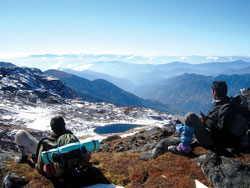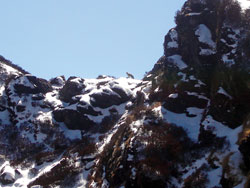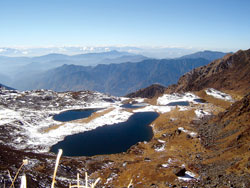|
|
Saraswati Puja has come and gone, the days are getting warmer in Kathmandu (the air dustier and the smog thicker). We can now say that spring has arrived for this year. But up in Sindhupalchok, on the trekking route to Panch Pokhari, to most intents and purposes it is still winter, at least it was several weeks ago when we visited there.
The rhododendrons were not out, there were still large stretches of unmelted snow, and it was bitterly cold as soon as the sun went down.
Admittedly it was early in the year for trekking, but we got the chance to see everything still pristine from the winter. With clear skies, there was not a wisp of cloud, not a hint of rain. Just a bright and pale sun. As long as it was shining, the air was cosy - warm, even. But the nights in the tent were subzero.
The trail used to start at Chautara but now there is a rough track all the way to Sano Okhreni, which saves four hours of walking. At this point, I must warn you: there is absolutely no water on the main trail to Panch Pokhari, as it follows the ridge and there are no springs. Being this early in the year though, we were able to melt and drink snow.
Early on there are one or two uphill stretches of moderate steepness, but then the monster hits you. From then on it's ukalo for the rest of the day until, with luck, you arrive at Bhanjyang.
|
|
Despite our GPS, compass and map, we got lost along the way, wandering for three or four hours among dwarf bamboo and thorn bushes. That's what happens when the single-track path you are following disappears beneath an avalanche of snow and you only have five head torches among a group of 11. Bhanjyang, which is one cowshed, had two human occupants when we arrived, and they were the only other people we saw during the entire trek.
Day two was steeper. The choice was a straight 60-degree climb over boulders, or a longer, more leisurely path to Hille Bhanjyang, announced by the presence of two more cowsheds. We boiled snow and drank tea.
If you take the steep, direct route, you can get beyond Hille to the pass at Narsingpati by evening. Here the Jugal Himal seems within touching distance. There was soft, powdery snow all around, a shed to sleep in, and even dry firewood. And the view from here is indeed one to die for, assuming you haven't already passed away on the steep path up.
At this time of year, you can watch the big orange sun slowly slide through a clear sky into the western horizon, flashing rays of yellow light straight on to the mountains. And far off below to the south is Kathmandu Valley with its twinkling lights.
On the third day, we reached Panch Pokhari. It's a three or four hour walk from Narsingpati or a day's walk from Hille Bhanjyang. At last the gradient is easier, the snow not so slippery. And, it must be said, Panch Pokhari is worth the torture.
|
|
The five tarns lie in a sheltered vale below Dorje Lakpa, the largest surrounded by the other four. There is a temple, from the base of which flows a freshwater spring. You can easily camp here for a day or two, although the evening winds can be strong and chilly. Peg out your tent properly or you'll be running after it in the night.
From the lakes, it's a day's walk to Dudh Pokhari, and one day more to Tilman's Pass, more than 1,000m further up, which offers a difficult way over to the Langtang valley and Kyanjin Gompa. From the hilltops flanking Panch Pokhari, the pass can be seen clearly - a glacier guarded by Gang Chhenpo. The return is easier, slithering and sliding down the icy paths. It should take two days, one to Bhanjyang and another to Lamidanda.
As spring arrives, the route comes alive. The cowsheds will have friendly cowherds and mooing yaks. There are even a few seasonal shops along the way that sell strong chyang to put an extra jolt into your step. You can meet people coming down or going up, often followed by a big hulking mastiff. As the weather warms, the route becomes easier and more sociable. But spring trekkers will not experience the quiet solitude that we knew.





